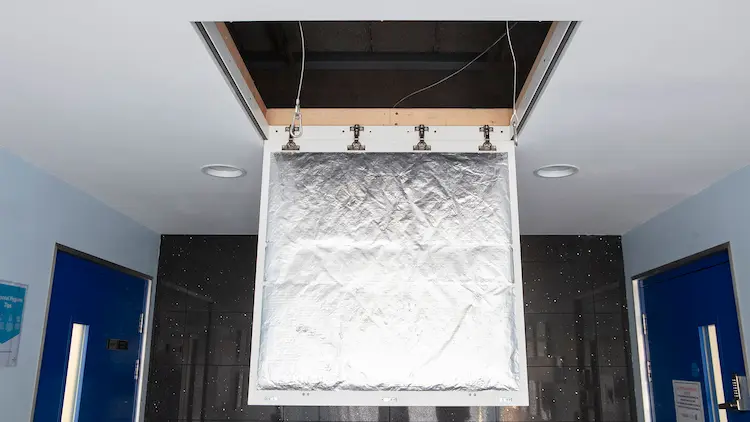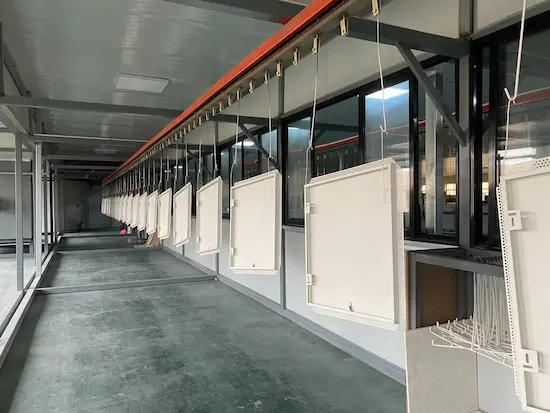What Cost Advantages Do Ceiling Access Panels Bring to Commercial Construction Projects?
Tired of expensive repairs of ceilings and the slow pace of maintenance delaying your projects? Ceiling access panels are introduced to smart builders to reduce the time required for repairs, prevent damage, and lower the overall project cost. The following way these panels deliver a real commercial construction cost advantage to the knowledge.
Why Access Panels Matter in Commercial Builds?
Ceiling access panels are important in ensuring that commercial projects are efficient, economical and simple to maintain. They can ensure that interior finishes are safeguarded by reducing invasive ceiling cuts, making repairs faster and reducing downtime in occupied spaces significantly with a standard price of $10 to $400 and an expected cost of installation of about $200-$500 per unit. That is the reason they provide one of the highest ROI upgrades in contemporary construction.
Located correctly, access panels will assist the teams to prevent rework, reduce interruptions and performance of the building over the long term despite the need to access the HVAC, electrical and plumbing systems.
Also Read: How Do Drywall Access Panels Save Time & Money in Commercial Construction?
Key Cost Advantages of Ceiling Access Panels in Commercial Construction
Reduced Maintenance Labor Costs
Ceiling access panels save service time directly by allowing access to HVAC, electrical and plumbing systems. Rather than chopping holes in the ceiling and sealing them afterwards, technicians can finish work 20-40% quicker, decreasing the number of billable labor hours and accelerating regular check-ups on busy business areas.
Lower Ceiling Repair and Restoration Costs
Each time a ceiling is unscrewed without a panel, companies have to incur an extra expense of $200-$500+ in repairs, patching and putting in a fresh coat of paint. That is almost free after installation with an access panel. This not only saves a repeat of the restoration work but also maintains interior finishes clean, even and unharmed.
Minimizes Business Downtime
Downtime is costly in places such as the retail stores, hospitals, hotels and offices. Cutting, repairing and repainting ceilings can effectively put a part of a building out for a few hours or days. The access panels make it easier and they also reduce the maintenance period by half or more and the business can remain fully operational with minimal disturbances.
Higher Lifecycle ROI
A typical ceiling access panel would range in cost between $200-$500 installed, yet the savings in the long run would be significant. These panels will save thousands of dollars throughout the life of a building. This is compared to traditional ceiling panels. The savings come from eliminating the need to repair broken ceilings and saving labor hours. They also provide the fastest possible access to a system. This all proves them to be one of the highest payback additions in the commercial building industry.
Prevents Code Violations and Rework Costs
Fire-rated ceiling systems should have appropriate fire-rated access points. The improper panel may cause inspection failure, rework that is expensive to do or a delay of the project. By installing fire-rated access panels that are compliant and of adequate this risk is completely removed and keeping your budget intact and even keeping your project safe and code-ready at the start.
Typical Cost Components of a Ceiling Access Panel
Product Cost (Material Type and Build Quality)
The ceiling access panel itself will cost much depending on the material used, size and fire-rating. Standard metal or plastic panels are usually sold between $10-$400, whereas the expensive flush drywall or tile-in or acoustical panels are sold at a higher price because of their better appearance and stability. The most costly are fire rated models which can range between $250 and $2000 due to the certification and insulation. Choosing the right panel balances budget, performance and code compliance.
Installation and Labor Costs
Ceiling access panels are also subject to a high cost in regard to labor. Simple ceiling installs take an average of $200-$500 which includes the panel. Such complicated installations as fire-rated panels, reinforced framing or unique finishes need more skilled labor and time. Proper installation will allow the panel to install flat, work well and avoid damage to the ceiling which will save your investment and reduce future repair and compliance problems.
Lifecycle and Long-Term Costs
Lifecycle costs are usually greater than the initial purchasing and installation costs. In the absence of ceiling access panels, the process of maintenance may involve cutting, patching, and repainting which is estimated to cost $200 to $500 and above per service procedure. In the long run this translates to thousands of unnecessary repair expenses on the building. Panels save time on labor, offer finishes and fasten diagnostics, which would save significant time in the long run, which is why they are a high ROI option in a commercial construction project.
Here are some estimates for standard ceiling access panels.
| Size | Steel (Basic) | Aluminum (Basic) | Plastic / PVC | Gypsum / Drywall | Fire-Rated Option |
| 12×12″ | $25 – $75 | $35 – $95 | $15 – $45 | $30 – $75 | $150 – $300 |
| 18×18″ | $45 – $160 | $55 – $180 | $20 – $65 | $50 – $150 | $200 – $400 |
| 24×24″ | $70 – $230 | $80 – $260 | $30 – $95 | $65 – $210 | $250 – $500 |
| 36×36″ | $150 – $350 | $175 – $380 | $60 – $180 | $140 – $300 | $400 – $750 |
| 48×48″ | $220 – $520 | $250 – $620 | $100 – $280 | $200 – $440 | $500 – $1,000 |
How Access Panels Reduce Repair Costs and Extend Ceiling Life?
Intelligent ceiling access panels are also a good selection when it comes to commercial buildings since they will not end up causing deprivation of repetitive ceiling damage during maintenance. Technicians have to drill through drywall or plaster to do the HVAC, electrical work and plumbing, which can cost them up to $200-$500+ repair. Access panels do away with this requirement, leaving ceilings intact and finishes intact.
These panels will enable the reduction of wear and tear on ceiling materials, less patching and repainting and increase the total lifespan of the ceiling since direct, reusable access is available. This reduces the cost of repair over time besides ensuring the building’s aesthetics and structural stability.
Quantifying Downtime Savings for Commercial Buildings
Ceiling access panels save a lot of time relating to maintenance of busy commercial areas. Traditional ceiling repairs may close off areas in retail outlets, offices or hospitals and influence revenues and productivity by taking hours or days. Maintenance time is also cut by 30-50% with access panels, which means that technicians can operate fast without causing any disturbance in operations.
Not only does this accelerated access save money in terms of labor, but it also keeps businesses fully operational which makes the day-to-day operations run smoothly and the overall efficiency increases.
When to Choose Fire-Rated vs Non-Fire-Rated Panels?
The choice of a proper access panel ceiling type is an important consideration that is concerned with safety, compliance and cost-efficiency. There are non-fire-rated panels that suit normal ceiling applications where building codes do not demand rated assemblies. They are cheaper, installable and suitable for general maintenance access.
Also Read: Why Should Fire-Rated Access Doors Be Included in Commercial Construction Estimates?
However, here, fire-rated panels should be used in ceilings that interpenetrate fire-rated assemblies such as in hospitals, schools and in commercial buildings with high code standards. These panels are expensive as a result of insulation, UL certification and other installation processes. Although it will be more costly in the short run, they will eliminate code violations, expensive rework and inspection failures, saving your investment and ensuring long-term safety. The selection of the correct panel type trades off compliance, functionality and lifecycle cost savings.
Design, Size and Finish Options That Affect Cost
Ceiling access panels are available in different designs, sizes and finishes, all of which influence the cost and functionality. Frames made of standard metal are cheap, whereas flush drywall or tile-in panels are not only incompatible with ceilings, but also are more expensive.
Making larger panels or even custom sizes adds both material and labor costs, and finishes such as painted surfaces, inlays or security locks add to the price. The choice of the appropriate mix guarantees the aesthetic value, usefulness and extended savings without affecting the quality of the project.
Best Placement and Coordination Tips to Avoid Costly Rework
The positioning of access doors and panels is strategic to ensure that there is easy maintenance, less labor expenditure and no costly rework. The coordination and design between the MEP engineers and contractors and the architects is significant. When making decisions concerning locations, functionality and aesthetics ought to be considered.
Placement tips:
- Position near HVAC, plumbing and electrical systems for direct access.
- It is not necessary to visit high-traffic or sensitive areas.
- Combine multiple systems as much as you can in order to reduce the number of openings.
- Coordinate with ceiling lights, ducts and structural components to avoid conflicts.
- BIM/CAD drawings should include panel locations as a good way of planning construction.
ROI Case Study
Real Cost Savings Examples
Ceiling access panels can save a lot in the long run. In the case of a small office fit-out of 10 panels, the yearly maintenance costs are reduced by $1500-$2000. In a mid-size retail environment of 30 panels, this can $5000–$7000 per year in repair and labor costs. Additionally a hospital wing of 50 fire-rated panels will not have to spend thousands of dollars in downtime and ceiling repair and this will save thousands of dollars in lifecycle savings over the life of the structure.
Specification and Procurement Checklist
Make sure your access panels meet project requirements by including key details in your RFP:
- Panel size, material and finish
- Fire rating and UL certification if required
- Installation method and labor expectations
- Lock type or security features
- Warranty and maintenance instructions
- Delivery lead times and inspection criteria
Conclusion
Ceiling access panels can bring commercial projects measurably low costs such as lowered costs of repair and labor, minimized downtime and increased lifecycle ROI. The right choice, positioning and installation will provide the savings in the long term without renovating the appearance of the building and its compliance. For expert guidance on specifying, sourcing and installing access panels, trust USA Estimators. Share your project information now and receive a free cost analysis customized to your commercial space!
FAQs
How expensive would ceiling access panels in a business building be?
The common ceiling access panels cost between $10 and $400 to get regular versions and the overall cost of installing the panel is between $200 and $500 on average. Both fire-rated or custom panels are more expensive but they cost less in the long run less in labor and repair making them a worthwhile investment in commercial building.
Will fire-rated access panels eliminate the expensive rework?
Yes. Access panels are fire-rated and in accordance with building code and UL standards. Proper selection of the panel type will ensure zero inspection failures, costly rework will be avoided and you will not put your project budget at risk and the same time keeping your project safe and functional.
Do access panels lower the cost of maintenance?
Ceiling access panels enable direct access to HVAC, plumbing and electrical systems that resulting in fewer labor hours and avoiding damage to ceilings and eliminating patching or repainting. This reduces the general costs of repairs and prolongs the lifespan of the ceilings of the building.







